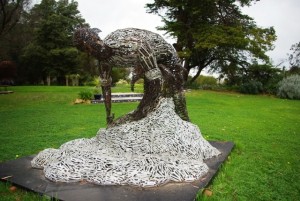
Once, there was nothing; we can’t even say “a long time ago”, because there was no time. Then there was something, all at once and in one area, expanding rapidly outwards. Then, after something had cooled enough, it gravitated together with more something until it formed a star. In the star, something got heavier and heavier; something became iron, calcium, potassium, oxygen. In time, the star exploded, sending something flying out in all directions. Eventually, something settled down and clumped together again. Some parts of something became stars again, and other parts of something remained around it, still forming. Some of these new formations became huge and gaseous, while others remained small and rocky, clinging to a small amount of gas. A few small, almost insignificant, fragment of something formed around a young low mass star as the planet we know as Earth. And on earth, a fragment of that something settled as hematite, taenite, kamacite, minerals with iron. Some of it went to the center and became part the core, while the rest of it remained on the surface and hardened.
For billions of years, something remained that way. Something witnessed the first living organisms and watch them grow more and more complex, going from one cell to several as complexity increased faster and faster. Something witnessed the life move from water to land, the rise and fall of the dinosaurs, and saw the first flower. Something bore witness to the end of eras, as organisms died and were lost forever, and saw others take the vacant spaces. Something saw the climate swing between hot and cold, felt the earth’s magnetic poles flip flop their polarity, and felt the tremors of the continents playing out their slow dance. Those parts of something were here when our ancestors first walked the planes of the land we call Africa, and they watched us slowly bend the laws of nature to our will, first with simple tools, then fire.
And then one day we realized that some parts of something had certain properties that we could use to our advantage. We melted iron ore and from it created weapons and tools that build and ruined empires and made us more than simple animals with sticks. Then we discovered that iron could be combined with coal to create steel. Some of that steel became wrenches, a symbol of industry and the working man. Some were used by the men who built the skylines of the world; others tightened the rivets of the tanks of the Americans, the Nazis, and the Soviets; others made sure that the automobiles and machinery of the civilized world would, when broken, work again. And some, after long lives of sweat and work, found themselves in this statue.
It is fitting, perhaps, that they find themselves here in a monument to their journey. Something, though tangible in the present moment, never stays the same forever. The iron in these statues was once part of a star, then part of the earth, then a tool and now finally a work of art. And in a way, the human form it takes is a reminder that we too were just like the iron in this statue: something floating in space that became a star, then a planet, and then a living being. It is a reminder that even though we will cease living some day, we will never truly leave this place.
Because no matter what, we will always be something.




I felt really hopeful at the end of this piece. I really appreciate stories that dismantle the usual way we think of life and death. I like the “threading” of the iron through the story. I think you could make more sue of this one element–it’s also the core of hemoglobin in out blood…so metal and muscle…both pass and endure?